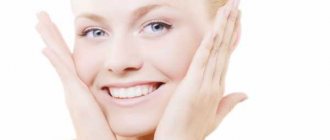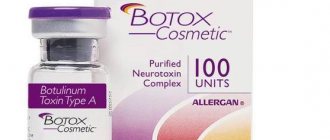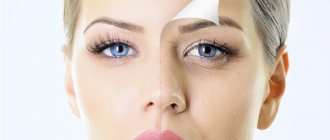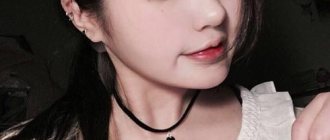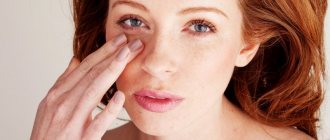Retinoic yellow peeling
Retinoic yellow peeling gets its name because of the bright color of the active ingredient that is used to treat the skin. The main substance of the composition is retinoic acid or retinol - a derivative of vitamin A or vitamin A, which is why the peeling is called retinoic or retinol yellow peeling.
Peeling with retinoic acid is a procedure with a chemical surface effect, but despite this, this method of rejuvenation is very effective and the results obtained are no worse than the average peeling.
Carrying out
In the cabin
It is preferable to carry out the procedure in a salon. It will be somewhat more expensive, but safer. Retinoic peeling is one of the chemical peels that require strict control and extreme care. The procedure involves preparation, which is an unconditional condition, otherwise there will be no desired result. This item is discussed at the initial consultation.
If it is impossible to carry out the preparation, which requires financial expenses, you will most likely be denied peeling. One procedure is usually sufficient. But it is permissible to carry out 2 - 3 procedures with an interval of 1 month (according to indications). It is recommended to repeat it after 6-12 months in cases where the skin is unable to produce collagen on its own.
Preparation
Preparation begins 3 weeks before the event. Key preparation points:
- Using retinoic ointment or skinoren gel according to the instructions,
- Carrying out 2 - 3 superficial peelings with fruit acids,
- Use only special care cosmetics that contain low concentrations of fruit acids.
Neglecting these preparation measures entails the risk of side effects and does not give the desired result from the retinoic peel itself.
Algorithm
The entire procedure takes about 3 hours in total. It starts with cleansing the skin.
- Cleansing. The skin is washed with warm water and dried, and a special cleansing composition containing salicylic and glycolic acids is applied.
- Applying the peeling mixture. Prepare the composition of the mixture in advance. The main component is retinoic or retinolic acid, the auxiliary component is ascorbic or phytic acid. The concentration is calculated individually in each case. Apply the solution with a special spatula, without touching the area of the eyelids and eyebrows. A uniform and dense layer of the solution hardens in about 20 - 30 minutes.
In case of rapid redness, the composition is immediately washed off and a nourishing gel is applied to the skin.
- After hardening, the peeling is removed like a film.
- Apply a nutritional composition (gel, balm). It should have an increased sun protection factor.
In some cases, repeated application of the solution is required, which depends on the individual characteristics of the skin and the degree of its damage. Different drugs require different application times, from 1 hour or more.
At home
Is it permissible to carry out the procedure at home? Yes, but you should know all the nuances of its implementation. When deciding to peel yourself, you should consult a cosmetologist and then strictly follow his instructions and recommendations. The algorithm for doing peeling at home is identical to doing it in a salon or clinic. An important condition: do not perform the procedure alone; someone must monitor the condition of the skin besides you in order to change the peeling layer in time.
Before carrying out the procedure at home, it is necessary to check the reaction to the components of the mixture. To do this, the solution is applied to the elbow area. If severe redness and itching are not observed, then you can use a peeling solution.
The video demonstrates the retinoic peeling procedure based on retinoic acid (vitamin A) for mature skin:
How does retinoic peel work?
The main substance helps speed up the work of dermal cells, which causes them to intensively produce collagen and elastin. In addition, retinoic acid has a bacterial effect, accelerates metabolism in cells, enhances reduction and oxidation processes, and accelerates the production of lipids.
In addition to the active component, the composition also contains other additional acids that help get rid of age spots and also enhance the effects of retinoic acid. This peeling is prescribed for treating the face, décolleté, face, eyelids and hand skin. Since yellow peeling is superficial and has a gentle effect on the skin without damaging it, it can also be performed on young girls.
Retinoic peeling has the following advantages:
- short rehabilitation period – up to 4 days;
- despite its mild effect, it is highly effective, especially in the fight against age spots;
- to achieve results, a much smaller number of sessions are required compared to peelings with other acids;
- is a safe way of rejuvenation;
- minimal risk of side effects.
Also, compared to other peels, retinoic peels have an affordable price.
The principle of action and effectiveness of Kosmoteros yellow peeling
Important: Retinoic acid, when applied to the skin, gives it an intense yellow tint, which gives the procedure its name. This is normal, since retinoids are colored substances. After exfoliation is complete, the skin will have a natural color
Kosmoteros retinoic peeling is prescribed not only to improve the aesthetic appearance of the skin, it is used for therapeutic and preventive purposes. Indications for use:
- therapy for dermatitis of varying degrees of complexity;
- treatment of acne, post-acne;
- preparation for surgical correction of the face;
- age-related skin changes: loss of elasticity, wrinkles, dull dermis tone;
- hyperkeratosis;
- rosacea;
- skin restoration after psoriasis;
- uneven complexion;
- prevention of skin diseases, prevention of neoplasms.
The solution to a complex of skin problems is solved thanks to the properties of retinoic acid:
- Restores the natural barrier properties of the epithelium. Local immunity is strengthened, which effectively fights the growth and reproduction of bacteria that provoke inflammation.
- Promotes the restoration of epithelial tissue, damage to which is a consequence of dermatological diseases. Scars and pigmentation become less noticeable or disappear completely.
- Evens out and brightens skin tone. Retinoic acid inhibits the activity of an enzyme that is involved in the formation of the melanin pigment.
- Protects the skin from negative environmental factors and fights free radicals. Retinoids actively protect skin cells from destruction, prevent the formation of tumors, prolong youth and remove toxic substances from tissues.
The Kosmoteros Yellow Peel, which has a simple protocol, is considered a “weekend exfoliation.” You can do it on the weekend, and by the beginning of the work week go to work with a young, radiant health face.
Retinoic facial peeling
Since yellow peeling has a mild effect, but at the same time is highly effective, this method of improving skin condition can be used to combat age-related changes, as well as at a young age. Facial peeling with retinoic acid is carried out in case of increased pigmentation, the presence of scars and acne scars, and facial wrinkles. Retinoic peeling can be used as a preventative measure for malignant skin diseases.
Yellow peeling is indicated for the following skin conditions:
- decreased skin tone;
- sagging, lack of elasticity and firmness;
- acne, pimples;
- dark spots;
- dullness of the skin;
- presence of scars and scars from acne;
- expression wrinkles.
This peeling helps prevent early skin aging and is also prescribed as a preparatory procedure before dermoplasty.
After yellow peeling, the following changes occur:
- the process of cell regeneration is accelerated;
- blood circulation improves at the peeling site;
- improves the process of collagen production;
- the level of oiliness and hydration of the skin is normalized;
- the skin restores its smoothness and elasticity;
- pigmentation is eliminated, the skin looks healthy and fresh;
- the structure is aligned.
Retinoic peeling has a positive effect on the skin after the first procedure, which in some cases is sufficient in the absence of serious problems with the skin. In most cases, for effectiveness it is necessary to carry out 3-4 procedures, between which it is necessary to maintain a gap of 2 weeks. The exact number of sessions can only be determined by a cosmetologist after a preliminary consultation.
Indications for use
The use of the yellow peeling procedure is recommended for a number of facial skin problems (both dermatological - acne, blackheads, pimples, etc., and age-related - wrinkles, creases, hyperpigmentation, etc.).
Key indications for retinoic facial peeling:
- facial wrinkles, creases;
- hyperpigmentation;
- keratosis;
- excessive functionality of the sebaceous glands;
- acne and post-acne;
- signs of photoaging;
- aging of the skin, its age-related changes.
- low skin elasticity and firmness.
How to prepare for the procedure
Before carrying out yellow peeling, mandatory preparation is required; you need to start 1-2 weeks in advance. If necessary, the cosmetologist may recommend light peeling to soften the skin. The doctor also prescribes special creams based on glycolic acid, which will prepare the skin for the procedure, this will help the active ingredients penetrate as deeply as possible under the skin.
It is important not to hide from the cosmetologist about the presence of any acute infectious diseases, poor health, malaise and taking medications. If there are any, a visit to a cosmetologist should be postponed for a while.
Advantages
Due to the large number of advantages, people most often leave positive reviews about retinoic peeling. The before and after photos presented in the article are a good example of how incredible results can be achieved.
The main benefits of peeling include:
- Safety. In its component composition, retinoic acid is similar to vitamin A. Based on this, there is no need to worry about the human body’s reaction to it. The mixture also contains some other acids that can enhance the effect of retinoic acid, which is the active ingredient.
- Delicate impact. Yellow peeling is rightfully considered one of the most gentle, so there are no obstacles to achieving noticeable results.
- Efficiency. Most specialists begin rejuvenating the skin of their patients with this procedure. In some cases, the effect of a couple of sessions is equal to 10 procedures with glycolic acid. The resulting effect lasts quite a long time – up to 4 months.
- Fast recovery. The face after retinoic peeling, of course, will peel and turn red, but all these problems go away very quickly. For final restoration of the skin, no more than two days are needed.
The essence of the procedure
Yellow peeling looks similar to a regular mask. Before the procedure itself, the specialist mixes the product in a container; if necessary, additional substances are added to help saturate the skin.
After the composition is ready, the patient lies on the couch and the cosmetologist begins to peel in stages:
- Before applying the peeling itself, the cosmetologist cleanses the surface of the skin from impurities, makeup, dust and sebaceous fat using a product.
- After cleansing, a composition consisting of glycolic and salicylic acid is applied to the skin, which will help prepare the skin and soften the stratum corneum as much as possible. After some time, the cosmetologist removes the remaining product and proceeds to the next stage.
- Using a cosmetic spatula, peeling is applied to the skin; it should be distributed as much as possible over the skin and have a dense but thin layer. When applied, the specialist does not affect the eyelid area, as well as the growth areas of eyelashes, hair and eyebrows.
The mask must be kept on the face for about 20 minutes, during which time it becomes harder. After time, the mask is removed with a film and the cosmetologist treats the skin with a special product with a high degree of sun protection.
Ingoda, the procedure can be carried out a little differently:
- Cleansing the skin with a salicylic acid-based product.
- Peeling is applied in several thin layers until slight redness appears.
- After several hours, the product is washed off with water and then treated with the product.
The method depends on the condition of the skin and the desired result.
After how many days can I apply makeup?
Girls are warned in advance, even before the procedure, that after it they will have to forget about decorative cosmetics for a while . Usually, a cosmetologist gives instructions on the period of refusal of makeup on an individual basis, because a lot depends on the type of peeling, skin sensitivity, and personal characteristics.
On average, until the skin has completely healed (12-14 days), cosmetologists do not recommend using cosmetics. But skincare cosmetics have their place. Even the cosmetologist himself, after the procedure, can make a list of products that can be used. These will definitely be soft nourishing and moisturizing products that can be used a day after peeling, and always with sun protection (SPF).
We recommend: 3 most popular types of peeling: what is better to apply to the face after each of these procedures?
Post-peeling care
Compared to the recovery period for other types of peels, which is usually about 2 weeks, the recovery period for the yellow peel takes only 5 days.
Skin treated with peeling during these days requires special care: regular use of masks, special moisturizers and nourishing products.
After the procedure, the cosmetologist gives the following recommendations:
- do not use decorative cosmetics and products containing retinoic acid;
- during this period, do not carry out hair curling, dyeing, etc. procedures;
- it is necessary to use only herbal natural remedies that can reduce irritation and inflammation;
- when peeling, do not touch the skin with your hands;
- wash only with boiled water;
- use masks with lactic acid, which will moisturize the skin and help the skin renew itself much faster.
During this period, it is strictly forbidden to use scrubbing agents and be in the open rays of the sun.
The need for post-peeling care
Facial care after yellow peeling is given such importance because of the composition of the product involved in the procedure. It is based on chemical elements, one of which is retinoic acid.
It has a strong effect on the skin, causing the removal of the top layer. This stimulates the growth and production of collagen and elastin. As a result, you can achieve facial skin rejuvenation in one way without additional procedures and products.
After using retinoic acid, wrinkles, unevenness, folds, rashes or blackheads disappear on the face. At the same time, pigment spots become lighter and skin color evens out.
This result can be achieved not only by using first-class preparations under the guidance of an experienced specialist, but also if post-peeling care was performed correctly, the skin will quickly return to shape.
However, not all patients who agree to a retinoic acid peeling procedure know how to care for their skin after the procedure. Lack of awareness can lead to negative results and in some cases, skin problems in the future. Therefore, it is important to familiarize yourself with the basics of epidermal restoration.
Contraindications
Like any type of peeling, retinoic peeling has contraindications:
- increased sensitivity to peeling components;
- the presence of acute viral diseases;
- warts and moles on the treated area;
- increased sensitivity to sun rays;
- taking certain medications;
- pregnancy;
- breastfeeding period;
- skin diseases;
- liver diseases.
When planning a pregnancy, you should not use retinoic peeling; it is better to resort to other methods of cleansing the skin.
If the patient constantly suffers from allergic reactions, in order to avoid complications, the doctor performs a sensitivity test; if there is no reaction, the cosmetologist performs the procedure.
Retinoic peeling: indications and contraindications
The procedure is recommended when the first signs of skin aging appear. The procedure also has a good effect on young skin with acne.
The main indications include:
- wrinkles and folds on the skin;
- dull complexion;
- keratosis;
- hyperpigmentation;
- acne and acne marks;
- scarring;
- increased skin greasiness.
Contraindications include:
- acute dermatological diseases;
- inflamed areas of skin;
- exacerbation of herpes and other viral skin diseases;
- feverish conditions;
- during pregnancy and lactation;
- chronic hepatitis and other liver diseases;
- intense exposure to ultraviolet radiation for one to two weeks before the procedure;
- intolerance to retinoic acid.
Side effects
Before performing the procedure, the cosmetologist warns the patient about possible side effects that can be avoided by following all the specialist’s recommendations. It is also important that the procedure is performed only in specialized centers where they use high-quality products and employ only qualified workers.
A reaction can occur due to the individual characteristics of the body, so it is important to inform the cosmetologist about the presence of diseases, which will reduce the risk of complications several times.
A couple of days after the procedure, the following side effects may occur:
- dry skin;
- tightness;
- peeling;
- the appearance of pink areas and redness;
- soreness;
- increased skin sensitivity;
- swelling.
These side effects almost always occur, which is the norm. To relieve discomfort, you need to use special products prescribed by a specialist that can moisturize and soothe the skin.
After what time can you drink alcohol?
A natural question that arises in a person’s head after the procedure is when can you drink alcohol after peeling?
After receiving the answer to the question whether you can drink after peeling, you need to figure out after what period of time you can drink your favorite drink again or have a feast for any reason.
Firstly, you should not drink between cleaning procedures, no matter how much there is. Secondly, the minimum amount of time you will have to endure after the last procedure is 30 days. It is a mistaken belief that after the visible effects of peeling have passed, all restrictions can be removed. If you do this, you can seriously harm your facial skin.
30 days is the minimum period of abstinence from alcohol. Accurate information can be obtained from the cosmetologist who performed the cleaning. He will observe the rehabilitation process and draw conclusions based on his observations. In some cases, the dry spell period may extend for 90 days.
Recommendations from cosmetologists, thanks to which you can maintain the result without negative consequences:
- During the rehabilitation period, it is prohibited to increase physical activity. The treated epidermis is weak. It is sensitive to any stress, increased pressure or body temperature.
- It is strictly forbidden to go to a sauna, bathhouse, warm up, wash in a warm shower, wet your face with running water, dry yourself with a hard towel or use a washcloth. All of these actions can lead to redness and skin rashes.
- During the rehabilitation period, it is necessary to use only skin care products recommended by a cosmetologist. The use of third-party creams, ointments, scrubs and masks can lead to serious complications.
- After chemical cleansing of the face, redness of the upper layers of the epidermis and peeling are normal. To avoid infection and aggravate the situation, you should not peel off flaky skin. It needs to be moisturized as often as possible. Otherwise, inflammatory processes may intensify, purulent formations may appear, and scars may remain on the skin.
- Do not use masks, scrubs, creams, lotions and shampoos with large particles.
- There is much less need to touch the skin with bare hands. This way you can significantly reduce the risk of introducing pathogens onto its surface.
Mediderma retinoic peeling
Retinoic peeling Mediderma is a professional skin care product produced by a Spanish cosmetology company. Mediderma has a wide range, which includes compositions for any type of peeling: superficial, medium or deep. Mediderma is an effective and safe means for skin rejuvenation; in addition, it has a minimal list of side effects that do not appear with proper care.
In addition to retinoic acid, the Mediderma yellow peeling contains lactic acid, which helps get rid of age spots, refresh and brighten the skin. This remedy is useful if you have fresh stretch marks.
The rehabilitation period after retinoic peeling
Due to the use of chemical acids in the process of cleansing the face, the consequences of such drugs are similar to the consequences of burns. The intensity of this effect on the dermis will depend on two factors:
- consistency of the drug;
- because of how long it was held on the face.
As a result, the recovery period will depend on the impact caused to the dermis. However, standard post-peeling care includes:
- use of external preparations for moisturizing and care;
- regulation of nutrition, which directly affects the recovery time of the skin;
- elimination of negative consequences if they occur;
- compliance with the recommendations and advice of professionals in the field of cosmetology and dermatology.
Because after even the simplest chemical peeling, the surface of the face will become more sensitive. Therefore, it is important to pay attention to how to wash your face properly. During this procedure, avoid applying strong pressure to the skin, using scrubs or other harsh products. It is recommended to dry your face with a soft towel and light movements.
However, it is forbidden to wash your face in the first 12 hours after the procedure. In some cases, cosmetologists advise drinking water through a straw to minimize contact with moisture.
Expert opinion
Anastasia Zaslavskaya
Dermatologist, cosmetologist
A large number of cosmetologists suggest that for effective care you should use a cream with natural oils, which will make it possible to reduce sensitivity and prevent the evaporation of moisture from cells. Cosmetics should be based on vitamins and other components that promote skin healing.
It is important to understand that all care products, preparations for washing, as well as methods and methods of treatment in case of negative consequences should be prescribed by a professional. In this case, all skin characteristics will be taken into account, including reaction to components and other factors.
Retinoic peeling: price
The exact cost of the procedure depends on the number of sessions that need to be performed. On average, one session costs about 4,000 rubles and can vary depending on the area of the treated area. If it is necessary to peel an additional area, an additional payment may be required. The price of the procedure is also affected by the drug used for peeling. During the conversation, the specialist can offer several types of remedies that differ in the depth of impact, effectiveness and duration of action.
Procedure protocol
Yellow peeling Kosmoteros includes several stages in the protocol:
The preparatory stage is aimed at softening and removing dead epithelial cells so that exfoliation is more effective. Sensitive and dry skin does not require preparation. The preparation stage may include the following procedures:
- the use of creams or peelings based on fruit acids;
- using creams to soften the upper epidermis.
Important: do not sunbathe or use laser exfoliation before yellow peeling!
Carrying out the retinoic peeling procedure:
- applying glycolic acid to the face;
- using retinoic acid to exfoliate the face;
- maintaining a certain time;
- rinsing the product from the skin.
The cosmetologist selects the concentration of retinoic acid, as well as the duration of exposure, on an individual basis. Depending on the depth of exposure of the composition, superficial or medium exfoliation can be carried out. On the 2-3rd day the skin begins to peel off and come off.
Important! The crusts that form after exfoliation cannot be removed with your hands or exfoliated with scrubs. This can lead to the formation of scars and scars.
The cosmetologist will tell you how to properly do Kosmoteros yellow peeling and determine the course of procedures. There is a “two-day cleanse”, during which the composition is applied and washed off over 2 days. The effect of the procedure lasts from six months to a year. After this period, exfoliation with retinoids can be repeated.
Peeling with retinoic ointment at home
Conventional drugs containing retinoic acid are freely sold in pharmacies. You can buy them without a prescription. That is, buying a special ointment and using it at home will not be difficult.
The recipe for retinoic peeling at home is quite simple. To carry out the procedure yourself, you need to stock up on the following components:
- moisturizing cream;
- retinoic ointment;
- a tablespoon of water;
- glycolic cream;
- teaspoon of soda.
Many people are interested in how to do retinoic peeling at home, because this procedure will be several times cheaper than in a salon. In fact, there is nothing complicated about it. It is performed in several steps:
- cleansing the face of decorative cosmetics and wiping with a paper towel;
- applying and evenly distributing cream with glycolic acid over the surface of the face;
- skin treatment with a retinoic agent;
- applying a neutralizing mixture consisting of soda and water (45 minutes after the ointment);
- after 7 hours, rinse off the composition with warm water;
- moisturize the skin with regular cream.
As mentioned above, a slight burning sensation may be felt on the skin during the procedure. There is no cause for concern, since such a reaction only means that the composition reacts with the skin and the beginning of the process of cleansing and rejuvenation.
Immediately after the session, peeling begins. When performing peeling at home, it can last a little more than two days, but no more than a week. Under no circumstances should you manually assist natural exfoliation. This nuance must be taken into account, as there is a risk of damaging the skin. The best way to combat peeling during this period is frequent moisturizing with special products.
In the first days after peeling, redness will appear. They can only last a day or two. The skin will completely heal and recover within a week after the session.
You can secure a long-lasting effect by repeating the cleansing three times. That is, it is necessary to carry out the procedure once every three weeks, and then repeat the procedure again after six months.
Side effects and how to get rid of them
Can yellow peeling have a bad effect on the dermis, and what unpleasant consequences can be expected in case of improper care or a failed procedure? Usually, serious complications do not arise if manipulations were performed by an experienced cosmetologist. Careful study of the prohibitions on the use of retinolic acid also plays a significant role. If there were no contraindications, and after cleaning all instructions were carefully followed, side effects usually disappear on their own in just a few weeks.
The consequence of the procedure is usually peeling, which usually indicates that the retinol has successfully completed the task and skin renewal has begun. It is recommended to use preparations containing hyaluronic acid or oil. Usually, in the absence of complications, peeling stops in just a week.
A red face after manipulation with retinoic acid is another problem that can await women. If a superficial effect on the skin was carried out, the redness usually disappears after a few days; with deeper penetration of the active components, the trouble can drag on for half a month. It is recommended to avoid excessive physical activity, which stimulates blood flow to the affected epidermal tissues.
Often after manipulation, swelling appears, which can cause a lot of trouble. Treatment after a retinol peel for this side effect includes the use of antioxidants. You can use a cream that reduces swelling, but it is better to do this only with the doctor's permission.
Rashes are another problem that can appear on the face after using aggressive medications. Most often this happens due to the fault of a cosmetologist who did not test the composition on the dermis. In such cases, facial skin care will have to begin with taking antihistamines, selected individually by the doctor.
Do you know? Often women complain of infection in the epidermal tissue. Most often this happens due to the fault of the ladies themselves, who cannot wait for the peeling to end and remove pieces of the skin on their own. It is these actions that contribute to the penetration of infection into the dermal tissue, which can lead to unpleasant complications.
Advantages and disadvantages of yellow peeling
Retinoic peeling
helps rejuvenate skin cells. The procedure belongs to the category of superficial-medium peelings, affecting only the upper layer of the epidermis. Superficial cleansing is good for the skin. It is impossible not to note the following advantages of yellow peeling:
- oxygen saturation of the skin;
- stimulation of collagen production;
- normalization of blood circulation;
- eliminating the consequences of acne.
The procedure has not only advantages, but also disadvantages. In particular, they note a long recovery process. For several days after the procedure, the skin will peel, hurt and itch. Crusts appear on its surface, the top layer comes off in layers. Many are put off by the high cost of the procedure.


